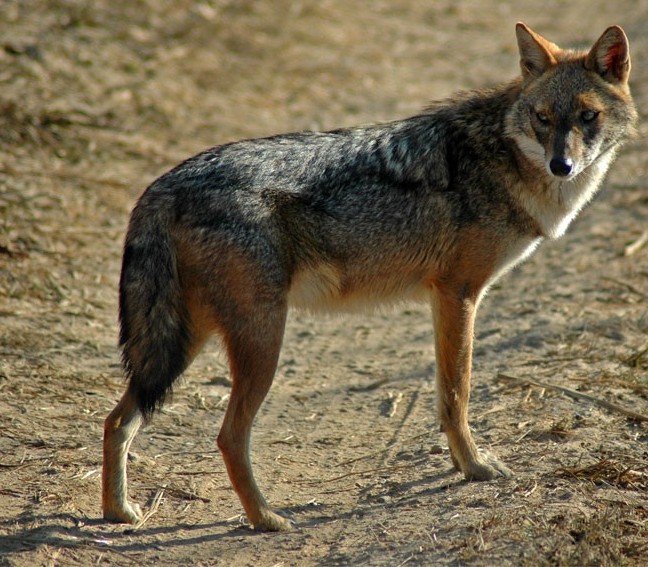
Golden jackal(Canis aureus)
Phylum —chordata
Class — mammalia
Order — carnivora
Family — canidae
Genus – canis
Appearance
The Golden jackal is similar to the Gray wolf but is distinguished by its smaller size, lighter weight, more elongated torso, less-prominent forehead, shorter legs and tail, and a muzzle that is narrower and more pointed. The legs are long in relation to its body, and the feet are slender with small pads. Males measure 71–85 cm (28–33 in) in body length and females 69–73 cm (27–29 in). Males weigh 6–14 kg (13–31 lb) and females weigh 7–11 kg (15–24 lb). The shoulder height is 45–50 cm (18–20 in) for both.
These jackals are widely distributed from North and East Africa to southeastern Europe and South Asia, including Burma.
Behavior
Living nearby human settlements, Golden jackals are strictly nocturnal. However, those living in other areas can be partly diurnal. The main social unit of these animals is a mated pair as well as a family, consisting of a mated pair and its young. Living in pairs, the jackals share most of their activity with the partners. Their behavior is strictly synchronized: they forage, hunt and rest together. As a matter of fact, hunting in pairs, they are three times more successful, than hunting alone. Jackal families hunt on a territory of about 2-3 sq. km. all year round. Looking for shelter, they frequently use caverns, dug by other animals. Golden jackals can also dig caverns themselves as well as use crevices in rocks. They are very friendly to their partners. Scratching one another all over their bodies is a common activity between mates.
Diet
Golden jackals are omnivores. These opportunistic foragers have a rather diverse diet. They feed on a wide variety of animal species such as young gazelles, hares, reptiles, ground birds and their eggs, fish frogs as well as insects. The usual diet Golden jackals also includes various fruits. During the winter months, they frequently eat rodents. In addition, they can consume carrion.
Reproduction
Golden jackals have monogamous mating system with females, fiercely defending the territory from other females. Thus they try to restrict access of female intruders to the male, not sharing him and preventing his paternal investment. Usually, a jackal family contains one or two adult individuals called "helpers". These are the ones, who, reaching sexual maturity, continue living with the parents for about a year. They do not breed and help the parents in rearing the next litter.
Breeding season takes place in the beginning of February or in the end of January (if the weather is warm enough), lasting about 26-28 days. After the gestation period of 63 days, the female gives birth in a den within the pair's territory. One litter can yield 1-9 babies, with an average of 2-4 pups. The female nurses the young for about 8 weeks, after which they are weaned. Females reach sexual maturity during the first year of their lives while male jackals become sexually mature within two years.
Golden jackals live eight to nine years in the wild and up to sixteen in captivity.
In captivity
In captivity, these animals require similar care to foxes, wolves, and dogs. Their enclosures should leave plenty of space for them to exercise and play, as well as lots of opportunities to hide.
Keepers feed them a variety of things, including rats, mice, rabbits, a ground carnivore diet, fruits, vegetables, berries, nuts, and more.
 Russian
Russian
 English
English























